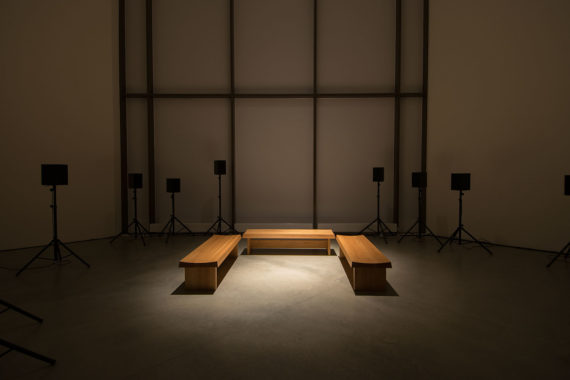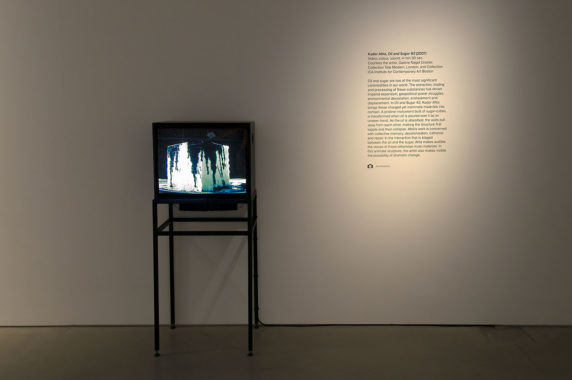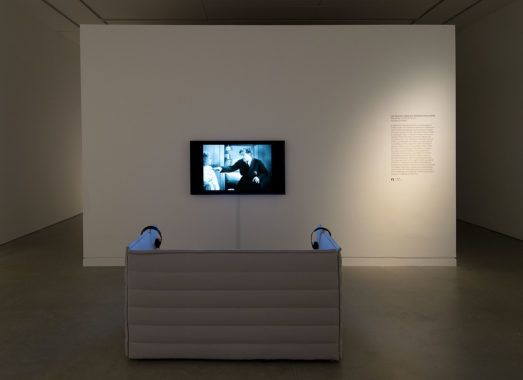PÁDRAIG SPILLANE REVIEWS ‘MANY VOICES, ALL OF THEM LOVED’ AT THE JOHN HANSARD GALLERY, SOUTHAMPTON.
The group exhibition, ‘Many voices, all of them loved’ at the John Hansard Gallery in Southampton (1 February – 14 March 2020), examines the relational facilities and powers of voice. Curated by Dr Sarah Hayden, the show explores how artists utilise various types of vocalisations as devices for sound occurrences and representation. It considers how the voice operates and is received in examining political expediencies. The six featured artists explore the power of voicing: its transmission and reception, as well as the ramifications of such transactional moments, coupled with ethical responsibilities. How do we listen to voices and what happens in that listening?
Emma Wolukau-Wanambwa’s video and stereo sound work, Promised Lands (2015–18), shows us a landscape near Lake Victoria in Uganda. A setting sun illuminates distant hills, seen through tree branches and back-lit foliage. In this unnamed space, the camera frame holds one fixed position. The receding light gently alters the sky from pink to near gloom. The work combines this durational showing of location with seven spoken word sections including read aloud texts, spoken conversations and intermittent subtitling. Wolukau-Wanambwa’s work attends to colonial migratory legacies that have marked Uganda and East Africa. A revealing moment is the artist reading from Austro-Hungarian economist Theodor Hertzka’s 1890 colonialist treatise, Freeland: A Social Anticipation. Wolukau-Wanambwa vocalises the elicitations of European ideas of East Africa as a utopic empty land, ready to be settled and occupied. The spoken word is interrupted by contradictory textual statements like “NOT YOUR ENCHANTMENT” and “NO BEING MOVED”. The work also features a conversation between the artist and her uncle, with certain indistinct parts described onscreen as ‘indecipherable’. What is recorded and what is given voice to is a conscious addressing of representation – of who and what is heard and what is not. As evening gives way to night, the scene subtly and continually refocuses, suggestive of Uganda’s complex colonial histories.

Laure Provost’s HD video, DIT LEARN (2017), also combines text, closed-captioning, image and voice. This work seems to acknowledge the viewer’s presence, first through a textual admonishment for lateness, and then via a masked figure, presented as a live video conference call, who whispers gratitude for your return after you had apparently been pushed out of the room. It is the artist who speaks in hushed and mischievous tones from a behind the mask, welcoming you back and inviting you to sit. The voice is instructional, directing us to understand an ensuing torrent of written, vocal and visual information.1 This playful and sometimes vigorous guidance prompts us as we attempt to learn a new language structure. A salamander moving its head to the right signals ‘yes’, while a clip of a wooden stake being hit with a hammer denotes ‘no’. It has a surreal, Alice in Wonderland feel – both a game and a test. Like a self-learning language app, you want to press pause to catch your breath, but this cannot be done. It is a giddy rush of not knowing, with an emerging recognition of connections between image and voice. Through its mix of flows and registers, the encounter alters our relations to the world and ourselves, as we realise there is potential for new connections and realties to form.
Willem de Rooij’s 12-channel audio installation, Ilulissat (2014), takes its title from the third most populated town in Greenland, where the sound recording was made. The space holds three wooden benches, situated in front of twelve speakers at different heights. Every thirty minutes, the lights dim, and the piece begins. In the dark, the speakers cannot be seen; only what emanates from them can be perceived. The sound of far-off dogs, gradually coming near and calling to each other, charges the air. These are not wild dogs but captive packs, adapted for human transport on glacial landscapes. As they draw nearer, the sound of the dogs’ interactions – excited howls, snarls, barks, whimpering and power plays – becomes denser and more amplified. These dogs are not free; they are captive, their pack instincts overthrown for domestication. With this in mind, the installation becomes a place of empathy.
Within her catalogue essay, Hayden includes a segment about dissimilar sensing and communicating entities, proposing an openness about what a voice can be. She states that it would be worrying “to render void any equation of vocality with humanity” exclusively. Within the exhibition, focus is placed on voices originating from corporeal and elemental sources. There is a hesitation towards synthetic voices emanating from programing or circuitry, suggesting an underlying uneasiness about future vocalities in prototype form. Perhaps such a notional voice, devoid of embodiment, does not sufficiently mirror the corporeal push of “wet tongues and constantly contracting and expanding tracheas”.2

There is no voice in Kader Attia’s video work, Oil and Sugar #2 (2007), making it an outlier in this exhibition, and all the more vibrant for it. What is shown, nearly filling the screen, is a white cube structure made from small sugar cubes, set upon a silver tray. An anonymous hand pours black oil over the sugary construction. The bleached crystalline quickly absorbs the slippery dark liquid and, after a short time, the construction falls in on itself, like a building being demolished. What were lines and incremental form now lie slumped in slow moving ruins. In the background is a subdued red brick wall, mirroring the sugar construction. We hear the faint interactions between oil and sugar, as it slips and drips off the polished tray. Muted traffic sounds mingle with the exchanges of sugar and oil, signaling the material world outside, where such affluences are extracted and produced. The symbolic powers of these colonial products are inverted, rupturing the status quo. The work offers a glimmer of how things can change, and how nothing lasts forever.
Captioned: Twentieth Century (2018) is an altered film by Liza Sylvestre, a full version of the 1934 screwball comedy, Twentieth Century, with supplementary white font captions appearing alongside the moving image. These captions are not typical subtitles, relaying what is said; nor are they describing onscreen action. They provide an alternative reading, based on the artist’s interpretations and point of view. Sylvestre identifies as D/deaf, after her hearing deteriorated in childhood. She relies on closed-captioning in relation to film, TV and other moving image works. Like many others, she has to figure out the conversations and actions happening onscreen, where no textual description is given. Through Sylvestre’s alternative captioning, we get to see the film in a different way, noticing things that may have previously been overlooked. For example, she notices a swastika on an object in the background and also comments on exaggerated gestures and their possible meanings. This alternative reading of the film, filled with humour and unexpected moments, asserts the position of someone who is D/deaf. To this end, the artwork uses captioning as a form of subjective and interpretative resistance.

Lawrence Abu Hamdan’s Conflicted Phonemes (2012) comes in formal blue vinyl with shelved paper stacks. This informatic, text-based work addresses forensic speech science – the application of linguistics, phonetics and acoustics to legal investigations – and how this process acts against Somali asylum seekers applying to enter the Netherlands. The active testing of asylum seekers looks for discrepancies in how their accents are formed, taking into consideration geography and other factors. If a voice does not match linguistic expectations, then the application for asylum is rejected. This test is given in full knowledge that there has been considerable movement of population over Somalia’s history, due to civil war. Conflicted Phonemes gathers information on the applicants’ claimed geographic origins. It is a counter-official installation whose quality and graphic styling gives the failed asylum seekers a moment to challenge the system – a system in which the voice is used against itself, thereby demeaning human subjectivity and identity.
‘Many voices, all of them loved’ proposes a reconsideration of the ethics surrounding the voice. In this regard, the strength of the exhibition is its responsibility to different voices, with listening framed as an ethical commitment. Just as Emmanuel Lévinas claimed that face-to-face encounter is the ‘first ethics’ in human sociality – as the human face “orders and ordains us”, based on “asymmetry towards the other” – then arguably a listening encounter holds similar phenomenological force.3 When we hear a voice, we decide whether or not to be receptive. What is the consequence of that? What are the first demands of a voice? What are our relationships to others and their vocality? As simply stated within its title, the exhibition suggests that we should value and listen attentively to the diverse agencies that share our world – it is a propositional reimagining of the acts of voicing and listening.
Pádraig Spillane is a Cork-based visual artist who works with photography, collage and assemblage. He is a lecturer at CIT Crawford College of Art & Design.
Notes
1 This torrent drive shows various voices and images as having implorings of their own. See for example: W. J. T. Mitchell, What do Pictures Want? The Life and Loves of Images (Chicago: University of Chicago Press, 2005).
2 Dr Sarah Hayden, exhibition catalogue essay.
3 Emmanuel Lévinas, Ethics and Infinity (Pittsburgh: Duquesne University Press, 1985) p 95.
Feature Image: Lawrence Abu Hamdan, Conflicted Phonemes, 2012, nine A4-sized vinyl prints, and nine stacks of printed A4 paper; photograph by Steve Shrimpton, courtesy the artist and John Hansard Gallery.



